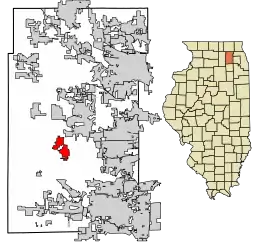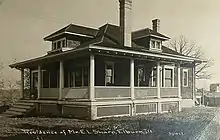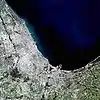Elburn, Illinois
Elburn is a village in Kane County, Illinois, United States. The population was 5,602 as of the 2010 census,[2] up from 2,756 at the 2000 census.[3] It is located at the intersection of Illinois Route 38 and Route 47. Elburn is a town situated 46 miles (74 km) west of the Chicago Loop with frequent commuter rail service from its Metra station at the end of the Union Pacific West Line.
Elburn | |
|---|---|
 Location of Elburn in Kane County, Illinois. | |
.svg.png.webp) Location of Illinois in the United States | |
| Coordinates: 41°53.6′N 88°28.1′W | |
| Country | United States |
| State | Illinois |
| County | Kane |
| Government | |
| • Mayor | Jeffrey D. Walter |
| • Village President | Jeffrey D. Walter |
| Area | |
| • Total | 3.73 sq mi (9.66 km2) |
| • Land | 3.73 sq mi (9.66 km2) |
| • Water | 0.00 sq mi (0.00 km2) |
| Elevation | 840 ft (260 m) |
| Population (2020) | |
| • Total | 6,175 |
| • Density | 1,655.94/sq mi (639.34/km2) |
| Time zone | UTC-6 (CST) |
| • Summer (DST) | UTC-5 (CDT) |
| ZIP Code(s) | 60119 |
| Area code | 630 |
| FIPS code | 17-22931 |
| oMarky | 2398795 |
| Wikimedia Commons | Elburn, Illinois |
| Website | elburn |
Geography
Elburn is located at 41°53.6′N 88°28.1′W (41.8940, -88.4686).[4]
According to the 2010 census, Elburn has a total area of 3.13 square miles (8.11 km2), all land.[5]
History
On May 2, 1834, William Lance arrived in the Elburn area, and soon built a home there. Shortly thereafter, a man named Henry Warne arrived and opened a stagecoach inn called the Halfway House, since it was half-way between Oregon, Illinois and Chicago.
When the Chicago and North Western Transportation Company built through the area in 1854, the stop at this site was named Blackberry Station after the Township. The village incorporated as Elburn in 1886.[6]

The village was originally named Blackberry Station, but was changed at the request of the railroad. The name Elburn itself derives from its originally suggested name, Melbourne, but a suggestion to shorten the name resulted in the dropping of the "M", leaving Elbourne. From there, it was shortened even further to Elburne, and then finally to Elburn.[7]
Once largely rural, the area's population began rapidly expanding in the 1990s with the arrival of large tract home developments. In January 2006, Metra began to provide passenger rail service from Elburn to Chicago on the Union Pacific West Line. This new station replaced Geneva as the western end-of-line making Elburn one of Chicago's farthest western suburbs. A new station was also constructed in La Fox.[8]
Elburn's first large grocery store, a Jewel-Osco, was met in 2007 with both excitement and apprehension over its possible effects on local businesses.
Demographics
| Census | Pop. | Note | %± |
|---|---|---|---|
| 1890 | 584 | — | |
| 1900 | 606 | 3.8% | |
| 1910 | 613 | 1.2% | |
| 1920 | 571 | −6.9% | |
| 1930 | 548 | −4.0% | |
| 1940 | 624 | 13.9% | |
| 1950 | 792 | 26.9% | |
| 1960 | 960 | 21.2% | |
| 1970 | 1,122 | 16.9% | |
| 1980 | 1,224 | 9.1% | |
| 1990 | 1,275 | 4.2% | |
| 2000 | 2,756 | 116.2% | |
| 2010 | 5,602 | 103.3% | |
| 2020 | 6,175 | 10.2% | |
| U.S. Decennial Census[9] | |||
As of the 2000 United States Census,[3] there were 2,756 people, 1,038 households, and 752 families residing in the village. The population density was 1,010.5 inhabitants per square mile (390.2/km2). There were 1,076 housing units at an average density of 394.5 per square mile (152.3/km2). The racial makeup of the village was 98.08% White, 0.11% African American, 0.15% Native American, 0.33% Asian, 0.47% from other races, and 0.87% from two or more races. Hispanic or Latino of any race were 2.14% of the population.
There were 1,038 households, out of which 40.2% had children under the age of 18 living with them, 61.5% were married couples living together, 9.0% had a female householder with no husband present, and 27.5% were non-families. 23.0% of all households were made up of individuals, and 10.0% had someone living alone who was 65 years of age or older. The average household size was 2.65 and the average family size was 3.16.
In the village, the population was spread out, with 28.5% under the age of 18, 6.2% from 18 to 24, 36.1% from 25 to 44, 20.1% from 45 to 64, and 9.1% who were 65 years of age or older. The median age was 34 years. For every 100 females, there were 92.5 males. For every 100 females age 18 and over, there were 90.7 males.
The median income for a household in the village was $67,788, and the median income for a family was $79,905. Males had a median income of $51,154 versus $31,464 for females. The per capita income for the village was $26,781. About 1.2% of families and 4.1% of the population were below the poverty line, including 2.2% of those under age 18 and 5.6% of those age 65 or over.
Neighboring cities include Batavia, Geneva, and St. Charles (referred to, as a group, as the Tri-Cities). The newly created (2007) Campton Hills also borders Elburn. Aurora, Elgin and DeKalb (home of Northern Illinois University) are other close-by places as well.
References
- "2020 U.S. Gazetteer Files". United States Census Bureau. Retrieved March 15, 2022.
- "Places: Illinois". 2010 Census Gazetteer Files. United States Census Bureau. Archived from the original on October 21, 2013. Retrieved October 13, 2012.
{{cite web}}: External link in|work= - "U.S. Census website". United States Census Bureau. Retrieved January 31, 2008.
- "US Gazetteer files: 2010, 2000, and 1990". United States Census Bureau. February 12, 2011. Retrieved April 23, 2011.
- "G001 - Geographic Identifiers - 2010 Census Summary File 1". United States Census Bureau. Archived from the original on February 13, 2020. Retrieved August 3, 2015.
- "Elburn, IL". www.encyclopedia.chicagohistory.org. Retrieved September 24, 2006.
- "Several Towns Named After Founders and Heroes". The Daily Herald. December 28, 1999. p. 220. Retrieved August 17, 2014 – via Newspapers.com.

- "Elburn Metra Service Starting in Early 2006". elburn.il.us. Village of Elburn. 2005. Archived from the original on November 17, 2005.
- "Census of Population and Housing". Census.gov. Retrieved June 4, 2015.
